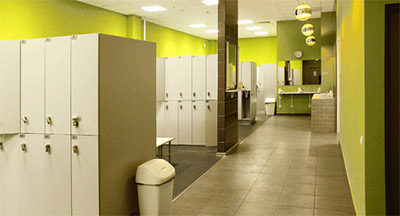Environmentally Friendly Locker Rooms Can Lead to Savings
Kelsey Cipolla, AIE
By: Kelsey Cipolla, AIE - June 1, 2013 | Originally published at www.clubindustry.com
Locker rooms are high-traffic areas that use large amounts of energy and water, and purchasing products that reduce the amount of energy and water wasted can be good for both the environment and a club"s bottom line.
The Columbia Association, a Columbia, MD-based nonprofit organization that operates three health clubs, implemented large-scale energy saving measures in its locker rooms, including energy recovery units that use existing heat in the air to help heat air coming in and reduce humidity. The association also installed a water-cooled condenser bundle that uses heat from the air to heat water being used for showers and laundry, which conserves energy.
“You really have to start with where you can make the most impact, and that would be the locker rooms," says Dennis Mattey, the Columbia Association"s director of construction.
Although these long-term investments come with a large upfront cost, Mattey says they make sense for his facilities and others that have significant energy costs. The Columbia Association also is in the process of constructing a new facility, which will feature recycled countertops, ceiling tiles and carpeting.
Using eco-friendly or recycled materials when constructing or renovating locker rooms allows health club operators to go green from the ground up. Environmentally friendly products can cost 3 percent to 5 percent more than traditional products, but many companies are now recycling old materials to make new ones as part of their manufacturing process at no additional cost to consumers, says Christa Plaza, owner of Essenza Architecture, a Louisville, CO-based firm that specializes in green design.
“For a long time, they were just so expensive, but now that"s starting to change," Plaza says. “It used to be kind of unattainable for some clubs. Now, it"s like almost everyone can do it if we design things properly and help them with the products."
Plaza says that installing low-water-use plumbing fixtures and LED lights, which use less energy and last up to 10 times longer than traditional incandescent lights, can make a big difference on utility bills.
Other Ways to Go Green
Lockers also can be made of recycled materials, but there are other materials and processes that help make lockers even more environmentally friendly. Using wood veneer instead of solid wood to make lockers reduces the amount of wood wasted by around 60 percent, which translates into fewer trees being used, says Rebecca Tearman, marketing manager for Hollman Inc., an Irving, TX-based manufacturer of environmentally friendly lockers.
Hollman lockers also go through a water-based UV finishing line, which does not contain volatile organic compounds, substances that can affect indoor air quality and have been linked to health risks, Tearman says.
Health club operators do not need to renovate their locker rooms to introduce green products. Even small changes can make a positive environmental impact, says Brian Kincaid, marketing director for health and fitness for GOJO, Akron, OH, which produces green certified hygiene and shower products.
Providing green hand sanitizers can help improve hygiene without requiring members to use water or paper towels, and green shower products reduce the amount of harsh chemicals that are rinsed down the drain and into the water supply, Kincaid says.
Using green products also can be a selling point for members.
“The environmental responsibility that the clubs take is becoming more and more important to members in their own daily lives," Kincaid says. “They"re becoming more educated and aware. If they"re putting down a significant amount of money for a health club, they want that health club to reflect their values as well."
For Healthworks Fitness for Women, Boston, the effort to go green began in 2007 as an extension of the company"s emphasis on the community and a way to differentiate the facilities. Healthworks eliminated paper towels and installed hand dryers. It also began using green cleaning products and switched to LED lighting, says Mark Harrington Jr., executive director of Healthworks. The decision to go green helped more than members and the environment, he says.
“Not only has it been good for our corporate image, but it"s also been helpful for the utilities," Harrington says. “It"s very easy to continue doing what you always do. It"s important just to take a look and evaluate the full impact. I think our CFO was surprised at some cost savings we could realize for doing something that was also good. It"s kind of a win-win situation."
